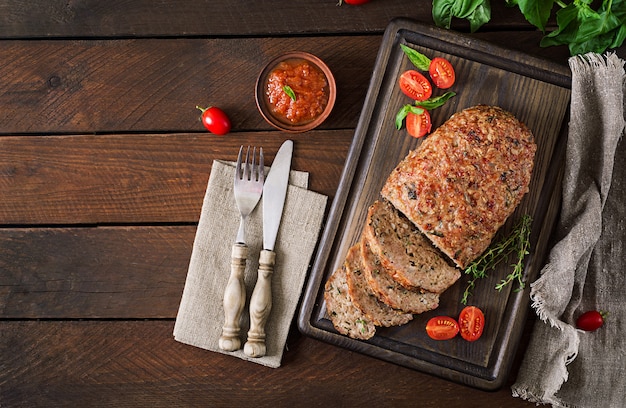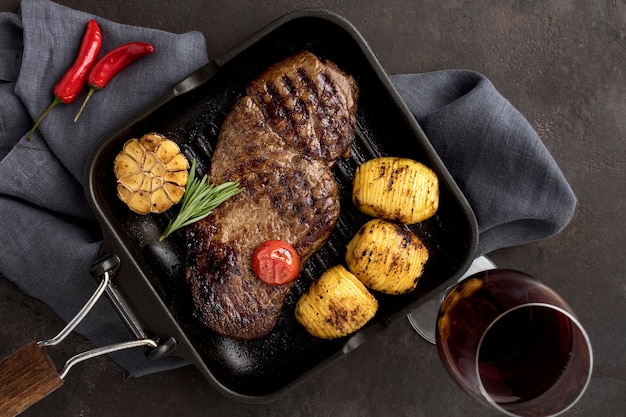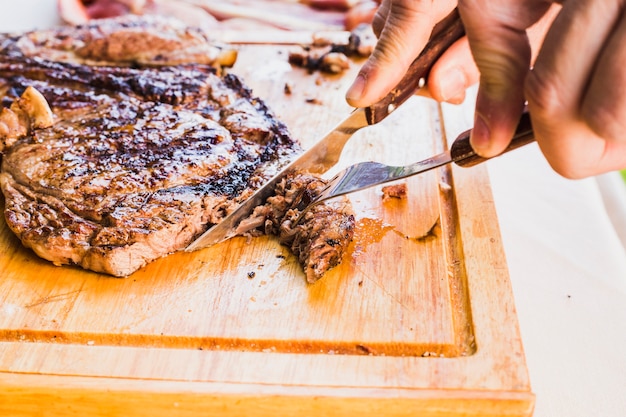Ah, prime rib. Just the name conjures up images of elegant dinners, glistening cuts of meat, and a symphony of aromas filling the kitchen. But let's be honest, for many of us, the thought of tackling a prime rib can be a bit intimidating. The fear of overcooking, the mystery of internal temperatures, and the pressure of achieving that perfect, melt-in-your-mouth texture – it's enough to make even the most confident cook feel a little uneasy.
But fear not, my fellow food enthusiasts! I've stumbled upon a culinary secret that transforms prime rib from a daunting challenge into a delightful, stress-free triumph. The secret weapon? The slow cooker.
This article is your ultimate guide to mastering slow cooker prime rib. We’ll delve into the nitty-gritty details, from choosing the perfect cut to unlocking flavour combinations that will leave you and your guests utterly impressed. We’ll cover the art of seasoning, the science of slow cooking, and even the secrets to creating a gravy that’ll make you want to lick the spoon clean. So, grab a comfortable seat, a glass of your favourite beverage, and let’s embark on this culinary adventure together.
(Part 1) The Prime Rib Primer

Before we dive into the slow cooker magic, let’s get acquainted with our star ingredient: the prime rib. Understanding the basics will make your journey to prime rib perfection much smoother.
choosing the right cut: A Matter of Flavor and Convenience
Prime rib is a cut of beef taken from the rib section, specifically the seventh to twelfth ribs. But within this family of cuts, there are two main contenders:
- Bone-in rib roast: This is the quintessential prime rib experience. A full rack of ribs stays intact, providing a unique flavour and helping to keep the meat incredibly moist. While it might require a little more effort in terms of trimming and carving, the results are truly worth it. This is my personal favourite for its intense flavour and impressive presentation.
- Rib Roast: This version comes without the bones, making it easier to handle and carve. It’s perfect for those who prefer a more streamlined cooking experience. However, you sacrifice some of the flavour and moisture that the bone provides.
Ultimately, the choice depends on your preferences and level of comfort. If you’re looking for the most authentic prime rib flavour and don’t mind a bit of extra effort, go for the bone-in roast. If you prefer convenience and a simpler approach, the boneless roast is a great option.
Size Matters: Feeding a Crowd or Keeping it Cozy
Prime rib comes in various sizes, allowing you to perfectly cater to your guest list. A general rule of thumb is to allow about 1 pound of prime rib per person for a generous serving. So, a 4-pound roast would comfortably feed a family of four.
However, this is just a starting point. Consider your guests’ appetites and whether you want leftovers for a delicious lunch the next day. If you’re serving a larger crowd, you might want to opt for a 6- or 8-pound roast. Don’t worry about the leftovers – we’ll explore some delicious ideas for transforming them into a new feast later on.
(Part 2) Preparing the Prime Rib: Setting the Stage for Success

Now that you've chosen your prime rib, it’s time to get your hands dirty and prepare it for its slow cooker journey. Don't worry, this process is much simpler than it might seem.
Trimming the Roast: Unleashing the Flavor
Trimming the roast is a key step in achieving that perfect prime rib. You're not trying to get rid of all the fat, but rather to remove any excess fat and connective tissue that could make the roast tough.
Here’s how to tackle it:
- Sharp Knife is Your Ally: Grab your sharpest knife – you'll be doing some precision work. A dull knife can make trimming a frustrating experience, and you might end up removing more meat than you intended.
- Fat is Our Friend: Remove any excess fat that extends beyond a 1/4-inch layer. That layer of fat is crucial for rendering during cooking, adding incredible moisture and richness to the roast.
- Membrane Removal: You’ll likely find a tough, thin membrane covering the roast. This is called the silverskin, and it needs to go. It can be tricky to remove, but with a sharp knife and a gentle hand, you’ll be able to lift it off, ensuring a more tender final product.
Remember, the key is to trim gently. You want to remove excess fat and connective tissue, but keep a good layer of fat intact. That’s where the real magic happens!
Seasoning the Roast: A Symphony of Flavors
Now for the fun part – seasoning the prime rib! This is where you can truly unleash your creativity and create a unique flavour profile. The most important thing is to season generously and evenly, so the flavours penetrate deep into the meat.
Here are some basic seasoning ideas to get you started:
- Classic Blend: A simple mix of salt, pepper, garlic powder, and onion powder is surprisingly effective.
- Herbed Elegance: Add some herbs, such as thyme, rosemary, or parsley, to your blend. You can either use fresh herbs, finely chopped, or dried herbs.
- Spicy Kick: For those who enjoy a little heat, add a pinch of cayenne pepper, smoked paprika, or a few slices of jalape??o.
- Sweet and Savory: A touch of brown sugar can add a delicious sweetness that complements the savory notes of the roast.
If you’re looking for a classic flavour, try a “peppercorn crust” by rubbing the roast with olive oil and pressing black peppercorns all over. It’s incredibly effective and adds a beautiful visual element to the roast.
Whatever your choice, be sure to rub the seasoning into the roast thoroughly, ensuring that every inch is covered. Let the roast sit in the refrigerator for at least a few hours, allowing the seasonings to penetrate the meat and develop their flavours.
(Part 3) The Slow Cooker Magic: Unlocking Tenderness and Flavor

Okay, you’ve prepped your prime rib, now it’s time for the slow cooker to work its magic. With the right techniques and a little patience, you’ll be rewarded with a melt-in-your-mouth prime rib that will have everyone asking for seconds.
Setting the Scene: The Slow Cooker Setup
First, ensure you have a slow cooker large enough to comfortably accommodate your roast. And for easy cleanup (who doesn't love a little shortcut?), use a slow cooker liner.
Place the seasoned prime rib in the slow cooker, fat side up. The fat will render during cooking, keeping the roast incredibly moist and adding a layer of richness.
The Liquid Decision: A Base for Flavor
Now comes the liquid. This is your opportunity to add depth and complexity to the flavour of your prime rib. Here’s where you can unleash your creativity and experiment!
Here are some tried and true liquid combinations:
- Classic Savory: A mixture of beef broth, red wine, and a dash of Worcestershire sauce creates a rich and satisfying base for the roast.
- Umami Boost: Add a splash of soy sauce to the mix for a hint of umami that takes the flavour to another level.
- Tangy Kick: A touch of Dijon mustard adds a tangy twist, balancing out the richness of the roast.
Feel free to experiment with other liquids, such as apple cider, chicken broth, or even a blend of fruit juices. The possibilities are endless!
The Slow Cooker Settings: Time for Patience
You’re almost there! Set your slow cooker to low and cook for 6-8 hours for the most tender results. If you’re short on time, you can cook it on high for 4-5 hours, but it might not be as tender as a slow-cooked prime rib.
Towards the end of the cooking time, you can increase the temperature to high for about 30 minutes. This will help to crisp up the roast and give it a beautiful golden-brown exterior.
(Part 4) Resting the Roast: A Crucial Step for Tenderness
It’s tempting to dive right into that beautifully cooked prime rib, but resist the urge! Let the roast rest for at least 30 minutes before carving. This resting period is crucial, allowing the juices to redistribute throughout the roast, resulting in a more tender and flavorful final product.
While the roast is resting, you can focus on preparing your sides. A classic pairing for prime rib is roasted vegetables, but your imagination is your only limit. mashed potatoes, Yorkshire pudding, creamed spinach – the choice is yours!
(Part 5) Carving and Serving: A Masterful Presentation
Carving a prime rib might seem daunting, but with a little practice, it becomes a breeze. You’ll need a sharp carving knife, a sturdy carving board, and a touch of confidence.
Here’s how to do it:
- Slice Across the Grain: Start by carving the roast into thin slices, making sure to cut across the grain. This ensures that the meat is tender and easy to chew.
- Bone-in Delicacy: If you’re using a bone-in roast, carefully carve around the bones, using your knife to gently separate the meat.
- Evenly Distributed Goodness: Aim for even slices, ensuring that everyone at the table gets a beautiful and satisfying portion of the roast.
Once the roast is carved, arrange it beautifully on a platter, alongside your delicious sides. Don’t forget the gravy – we’ll explore how to make a perfect gravy from your pan juices later.
(Part 6) Temperature Guide: Achieving Prime Rib Perfection
One of the biggest challenges with prime rib is ensuring that it’s cooked to the perfect level of doneness. You want it to be juicy and tender, but not overcooked.
Here’s a guide to the recommended internal temperatures for different levels of doneness:
| Doneness | Internal Temperature (°F) |
|---|---|
| Rare | 125-130°F |
| Medium-Rare | 130-135°F |
| Medium | 140-145°F |
| Medium-Well | 150-155°F |
| Well-Done | 160°F and above |
Remember that the internal temperature will continue to rise slightly after you remove the roast from the slow cooker. So, aim for a temperature about 5 degrees lower than your desired level of doneness.
(Part 7) flavor combinations: Beyond the Basics
We’ve covered the basics, but let’s explore some flavour combinations that will elevate your prime rib game. With a little creativity, you can create unique flavour profiles that will leave your guests utterly impressed.
Italian Inspiration: A Touch of Tuscany
For an Italian twist, add a handful of fresh rosemary sprigs and a few cloves of garlic to the slow cooker with the roast. The herbs will impart a fragrant aroma, while the garlic adds a hint of savory warmth. For an extra touch, add a splash of red wine vinegar, which will add a touch of tanginess to balance out the richness of the roast.
Spicy Kick: A Heatwave in Your Mouth
If you enjoy a little heat, try adding a teaspoon of smoked paprika and a pinch of cayenne pepper to your seasoning mix. The smoked paprika adds a smoky depth, while the cayenne pepper provides a subtle kick. For a more intense heat, you can add a few slices of jalape??o to the slow cooker.
Sweet and Savory: A Winning Combination
For a unique sweet and savory flavour combination, add a tablespoon of brown sugar to your seasoning mix. The brown sugar will caramelize during cooking, adding a beautiful sweetness that complements the savory notes of the roast.
Herbed Goodness: Fresh and Flavorful
For a simple yet elegant flavour, use a fresh herb blend like thyme, rosemary, and parsley. You can add these herbs directly to the roast or create a bouquet garni by tying them together with twine and placing them in the slow cooker.
(Part 8) Gravy Perfection: Transforming Pan Juices into a Delicious Sauce
No prime rib feast is complete without a delicious gravy. And the best part is, the slow cooker does most of the work for you. You have a pan full of flavorful juices waiting to be transformed into a rich and decadent gravy.
Here’s how to make it:
- Deglazing the Pan: Remove the roast from the slow cooker. Place the slow cooker on the stovetop over medium heat. Add a tablespoon of butter or oil to the pan and swirl it around to coat the bottom.
- Stir in the Flour: Add 2-3 tablespoons of flour to the pan and whisk it in with the butter or oil. Cook for a minute or two, until the flour starts to turn golden brown.
- Adding the Juices: Slowly pour in some of the pan juices from the slow cooker, whisking constantly to prevent lumps from forming.
- Bringing it to a Boil: Bring the gravy to a boil, then reduce the heat to low and simmer for 5-10 minutes, stirring occasionally, until the gravy has thickened.
- Seasoning to Perfection: Taste the gravy and adjust the seasoning as needed. You can add salt, pepper, or a pinch of sugar to balance the flavours.
If you’re feeling adventurous, add a splash of red wine to the gravy for a richer flavor.
Serve the gravy alongside your prime rib, and enjoy a symphony of flavors that will have you swooning!
(Part 9) Leftovers: Turning Your Roast into a New Feast
Let’s be honest, leftovers are a culinary treasure! And prime rib leftovers are a gift that keeps on giving. You can transform them into a whole new meal, ensuring that none of that deliciousness goes to waste.
Sandwiches: A Classic comfort food
One of the simplest and most satisfying ways to enjoy leftover prime rib is to make sandwiches. Slice the roast thinly and serve it on crusty bread with your favourite cheese, mustard, and a tangy pickle. It's a quick and satisfying meal that will make you feel warm and fuzzy inside.
Soup: A Hearty and Flavorful Delight
Turn those leftovers into a delicious prime rib soup. Chop the leftover roast into small pieces and add them to a pot of beef broth. Add some chopped vegetables, such as carrots, potatoes, and celery. Simmer the soup until the vegetables are tender. You can even add a dollop of sour cream or a sprinkle of fresh herbs for an extra touch of deliciousness.
Pasta: A Flavorful and Versatile Option
Another delicious option is to use leftover prime rib in a pasta dish. Simply slice the roast thinly and add it to a pan of cooked pasta with your favourite sauce. A creamy tomato sauce is always a winner, but feel free to experiment with other sauces, such as pesto, Alfredo, or even a simple olive oil and garlic sauce.
Don’t let your leftover prime rib go to waste. Get creative, and let your imagination run wild, turning your leftover roast into a new culinary masterpiece!
(Part 10) FAQs
What if my prime rib is too dry?
If your prime rib ends up a bit dry, don’t despair! You can add some moisture back in by making a gravy using the pan juices from the slow cooker. You can also slice the roast thinly and serve it on a bed of mashed potatoes or gravy. The key is to create a delicious and moist meal that will satisfy your cravings.
Can I add vegetables to the slow cooker?
Absolutely! You can add vegetables to the slow cooker, but it’s important to add them towards the end of the cooking time. If you add them too early, they’ll become mushy.
I like to add carrots, potatoes, or onions in the last hour of cooking. This gives them time to soften but still maintain their shape. You can also add other vegetables like Brussels sprouts, broccoli, or asparagus towards the end of the cooking time.
How long can I store leftover prime rib?
You can store leftover prime rib in the refrigerator for up to 4 days. Be sure to wrap it tightly in plastic wrap or aluminum foil to prevent it from drying out.
Can I freeze leftover prime rib?
Yes, you can freeze leftover prime rib. To freeze it, wrap the roast tightly in plastic wrap, then in aluminum foil. Place the wrapped roast in a freezer-safe bag. It can be frozen for up to 3 months.
How do I thaw frozen prime rib?
To thaw frozen prime rib, transfer it from the freezer to the refrigerator and allow it to thaw for 1-2 days. You can also thaw it in the microwave on the defrost setting, but it may not be as evenly thawed.
Congratulations, my friends! You’ve now mastered the art of slow cooker prime rib. Go forth and conquer the world of culinary excellence. Your next prime rib feast is sure to be a triumph, leaving your guests in awe of your cooking prowess. Happy cooking!
Everyone is watching

Corn on the Cob: The Ultimate Guide to Perfectly Cooked Ears
Healthy MealsAh, corn on the cob. Just the name evokes images of sunny days, barbecues, and that sweet, juicy flavour that ...

Perfect Pork Roast Oven Cooking Time: A Guide to Delicious Results
Healthy MealsThere's something truly satisfying about a perfectly roasted pork. The aroma alone is enough to make your mout...

Ham Cooking Time: How Long to Bake, Smoke, or Boil a Delicious Ham
Healthy MealsAh, ham. It's a classic, isn't it? A real crowd-pleaser, especially around holidays. And when done right, it'...

Scallops: The Ultimate Guide to Perfect Cooking
Healthy MealsAh, scallops. Those delicate, sweet, and utterly delicious morsels of the sea. They hold a special place in my...

Spaghetti Squash: The Ultimate Guide to Cooking and Serving
Healthy MealsRemember that time you saw spaghetti squash at the supermarket, looking all bumpy and strange, and thought, "W...
